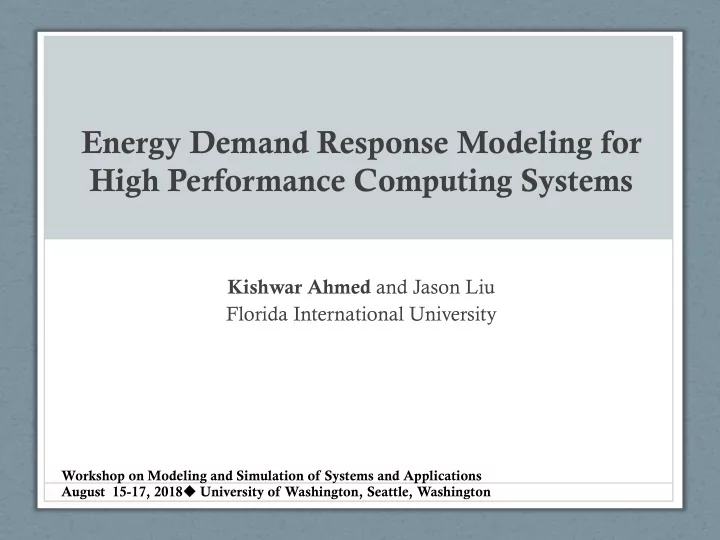

Energy Demand Response Modeling for High Performance Computing Systems Kishwar Ahmed and Jason Liu Florida International University Workshop on Modeling and Simulation of Systems and Applications August 15-17, 2018 u u University of Washington, Seattle, Washington
Demand Response • Participants reduce energy DR signal DR signal consumption during • Emergency events • High electricity price period Energy • Emergency demand response reduction • Mandatory energy reduction to target level • Economic demand response • Voluntary participation based on economic incentives 2
Why Demand Response? Financial benefits Environmental benefits Power system stability Ø Increase in demand response participation v Many well-known companies, such as Google, Apple, etc. v Participation in demand response to double in 2020 3
HPC is Energy-Costly! • Worldwide investment on supercomputers Other 8% • In 2016: $38 billion Mainteinance • Supercomputer’s lifelong 14% Hardware energy cost almost equals 36% investment cost Staff 14% • Advent of Exascale Power • 20MW à $20 million/year 28% for electricity Source: “Total Cost of Ownership in High Performance Computing. HPC data center cost considerations: investment, operation and maintenance.” in SoSE 2014 4
HPC in Demand Response • Can HPC systems reduce the energy consumption and energy cost through emergenc y and economic demand response participation? • Supercomputers are willing to participate [Patki et al., 2016; Bates et al. 2015] • Our solutions: • Emergency demand-response model • Application performance loss vs. energy reduction gain? • Economic demand-response model • How to incentivize HPC users for demand response participation? 5
Emergency DR Model • Power/performance prediction model • Empirical data • Polynomial regression • Demand response job scheduling • FCFS with possible job eviction (to ensure power limit) • Resource provisioning • DVFS, power capping, node scaling 6
Power/Performance Prediction Model Apply regression (quite a few alternatives) on power and execution time 250 120 800 Quantum ESPRESSO Quantum ESPRESSO Quantum ESPRESSO Gadget Gadget Gadget 700 Energy Consumption (KJ) 100 Seissol Seissol Seissol Average Power (Watt) Execution Time (Min) 200 WaLBerla WaLBerla 600 WaLBerla PMATMUL PMATMUL PMATMUL 80 500 STREAM STREAM STREAM 150 60 400 300 40 100 200 20 100 50 0 0 1.2 1.4 1.6 1.8 2 2.2 2.4 2.6 1.2 1.4 1.6 1.8 2 2.2 2.4 2.6 1.2 1.4 1.6 1.8 2 2.2 2.4 2.6 CPU Frequency (GHz) CPU Frequency (GHz) CPU Frequency (GHz) 7
Job Scheduling • During normal operation: • Traditional job scheduling • Optimized for best performance (max frequency) • During demand response period: • Minimize energy for resource allocation • DVFS, power-capping, node scaling • Reduce power limit • May have to evict some jobs 8
Resource Allocation • During normal operation • Run applications at maximum frequency for best performance • During demand response: energy conservation 9
Model Evaluation Vary system size: 128, 256, and 512 processors 5500 300 Performance-policy Performance-policy Average Turnaround Time (s) Demand-response (DR Event) Demand-response (DR Event) Demand-response (Non-DR Event) Demand-response (Non-DR Event) 280 Average Energy (KJ) 4500 Powersave-policy Powersave-policy 260 3500 240 2500 220 1500 200 1000 128 256 512 128 256 512 Number of Processors Number of Processors Reduced energy consumption at moderate increase in turnaround time 10
Economic DR Model • Economic demand response • Voluntary participation based on economic incentives • How to incentivize HPC users for participation? • Participation may introduce execution delays • Need a proper rewarding mechanism • HPC economic DR model • A contract-based rewarding mechanism to incentivize HPC users’ participations 11
Contract Theory • A formal (economic) study to develop contracts between parties • Principal: who offers the contracts (HPC operator) • Agents: who are offered the contracts and can accept/ reject (HPC users) • Widely used in theory and practice • Economics (e.g., managerial compensation) • Communication (e.g., cellular network) 12
An High-Level Example Type#1 User#1 à Type#2 ($1220, 15) User#2 à Type#1 Type#2 Type#3 User#3 à Type#3 HPC operator Job types HPC Users User’s utility maximized when selects own type’s contract 13
Resource Allocation 14
Energy and Reward 1600 18 Type#1 Type#1 16 Type#2 Type#2 1400 Energy Reduction (KWh) Type#3 Type#3 14 Type#4 Type#4 1200 Type#5 Type#5 12 Reward ($) 1000 Type#6 Type#6 10 800 8 600 6 400 4 200 2 0 0 12345678910 11 12 13 14 15 16 17 18 19 20 21 22 23 24 1 2 3 4 5 6 7 8 9 1 1 1 1 1 1 1 1 1 1 2 2 2 2 2 0 1 2 3 4 5 6 7 8 9 0 1 2 3 4 Time (Hour) Time (Hour) Energy reduction and rewards throughout entire time periods 15
Conclusions • HPC demand-response models • Emergency demand response participation • Economic demand response participation • A win-win situation to all: • HPC systems reduce energy cost • HPC users earn rewards • Power grid achieves energy reduction and power stability 16
Thanks! Acknowledgements: Kishwar Ahmed, Jason Liu, ModSim Workshop, August 2018 17
Recommend
More recommend